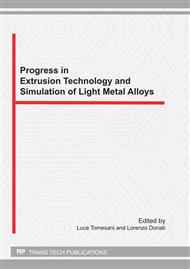p.75
p.81
p.89
p.97
p.105
p.113
p.121
p.129
p.137
Aluminium Extrusion Weld Formation and Metal Flow Analysis in Hollow Profile Extrusions of Different Section Thickness
Abstract:
Hollow and semi-hollow profiles are commonly produced by extrusion using porthole dies. The main characteristics of such dies are the presence of a mandrel (core) to shape the inner contour of hollow profile and bridges or legs to carry the mandrel. The bridges split the billet material into multiple metal streams that flow through the porthole channels and meet in the welding chamber behind the bridge where they are joined by pressure welding. When hollow profiles with different wall thickness are made the size of two adjacent portholes may be different. The material then flows through the two portholes with different flow velocity so that there is more feed through the bigger porthole into the weld chamber behind the bridge. Experiments have been performed and are reported here in which a grid pattern technique was used to characterize the metal flow through a 2D-die with porthole channels of unequal size. The design of the laboratory die has been modified in relation to the symmetric case to get different sizes of the two portholes. Since the metal flow through such a die is asymmetric the grid pattern technique was also modified to characterize the experimental flow. The results of an experimental metal flow study performed for a short billet was presented in a previous article [1]. Corresponding experiments performed with longer billets are now reported; so that two stages of the extrusion process is analysed here. The grid pattern technique has successfully mapped the non-symmetric material flow as in industrial extrusion when using different wall thickness over the section. The lateral movement of metal during extrusion is obtained from one set of experiments; the vertical movement from the other set. Finite element analysis of the extrusion process has been performed using Deform 3D. The encountering of the two metal streams behind the die bridge and the deformation characteristics within the welding chamber has been studied this way. Extrusion weld formation and deformations around the die bridge are considered here with the help of experimental results and simulation models. The nature of the metal flow achieved from the FE-model is compared with the experimental results. As regards the short billet some results are presented in [1], however improvement to the previous model gives a more perfect match. The model also provides information about the boundary conditions in real extrusion.
Info:
Periodical:
Pages:
105-112
Citation:
Online since:
September 2011
Authors:
Price:
Сopyright:
© 2012 Trans Tech Publications Ltd. All Rights Reserved
Share:
Citation:


